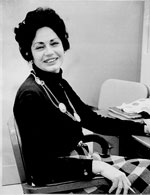 Liquid Paper was invented by a bank secretary form Texas in 1951. Bette Nesmith Graham, mother of of Monkees member Michael Nesmith, concocted the first correction fluid in her kitchen with tempera paint and a blender. Her second job as painter of holiday windows at the bank was the inspiration behind her invention. Graham noticed “with lettering, an artist never corrects by erasing, but always paints over the error. So I decided to use what artists use. I put some tempera water-based paint in a bottle and took my watercolor brush to the office. I used that to correct my mistakes.” Continue reading “Famous Women Inventors: Bette Nesmith Graham – Inventor of Liquid Paper”
Liquid Paper was invented by a bank secretary form Texas in 1951. Bette Nesmith Graham, mother of of Monkees member Michael Nesmith, concocted the first correction fluid in her kitchen with tempera paint and a blender. Her second job as painter of holiday windows at the bank was the inspiration behind her invention. Graham noticed “with lettering, an artist never corrects by erasing, but always paints over the error. So I decided to use what artists use. I put some tempera water-based paint in a bottle and took my watercolor brush to the office. I used that to correct my mistakes.” Continue reading “Famous Women Inventors: Bette Nesmith Graham – Inventor of Liquid Paper”

Category: A Moment in History
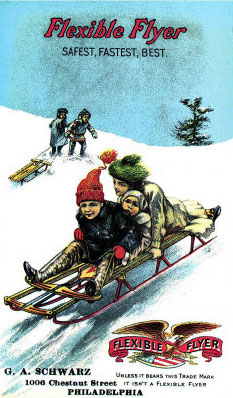 The Flexible Flyer was invented over 100 years ago by a farm equipment manufacturer. Looking to provide year round employment for his workers, Samuel Leeds Allen began trying to invent a sled in the 1880’s. Coasting, as sledding was then known, was very popular and Allen was hoping to capitalize on this.
The Flexible Flyer was invented over 100 years ago by a farm equipment manufacturer. Looking to provide year round employment for his workers, Samuel Leeds Allen began trying to invent a sled in the 1880’s. Coasting, as sledding was then known, was very popular and Allen was hoping to capitalize on this.
Allen’s first attempts at developing a sled were tested by the children at Westtown School in Pennsylvania. The predecessor of the Flexible Flyer was the Fairy Coaster which was a double-runner or bobsled which held three or four adults. Runners were made of steel and seats of a plush fabric. This entire sled could be folded into a small package for easy transportation on a streetcar or train. The problem with this first sled was a retail price of $50.00. This expensive price tag made it impossible to sell in quantity. A smaller cheaper version of this sled was designed but testing proved it to be too small and not have enough runner for proper steering. Eventually the entire production line for the Fairy Coaster was sold at auction. Continue reading “Making History: Invention of the Flexible Flyer”
Patent Plaques is now offering Trademark Plaques.
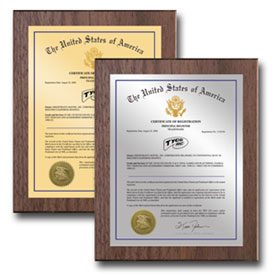
Our Premium Trademark Plaques have the finest details in the industry. Our color imprinting process enables us to reproduce your trademark registration with a clean, crisp image into the presentation plates, which are mounted on a solid wood plaque. We only use solid wood plaques for our Premium Trademark Plaques. These beautiful wood plaques come in your choice of Walnut, Cherry, Oak or a contemporary Black plaque.
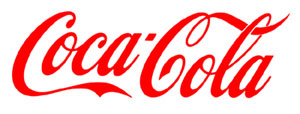 Would you believe the world’s best known brand got its name from a bookkeeper?
Would you believe the world’s best known brand got its name from a bookkeeper?
Frank M. Robinson, an accountant and partner in what would come to be an iconic soft drink, not only suggested the name Coca Cola; he designed the logo, too. The name was derived from the two main ingredients in the product: cocaine and caffeine. The cocaine came from the coca leaf and the caffeine from kola nut, leading to the name Coca-Cola. The K in kola was turned to a C for marketing purposes. Continue reading “What’s in a Name? Coca-Cola Trademark”
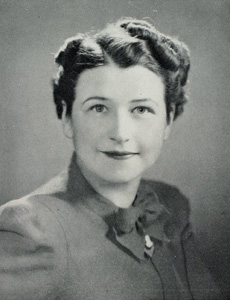 Chocolate chip cookies seem like a classic part of American baking like the apple pie, but actually these delicious cookies were not invented until 1933. Ruth Graves Wakefield was the woman who brought us these delectable treats. Built on the outskirts of Whitman, MA in 1709 as a collection booth for the toll road, Mr. & Mrs. Wakefield acquired the building in 1930 and transformed it into a restaurant and inn. The newly renamed Toll House Inn was a charming respite for weary travelers, boasting comfortable lodgings along with homemade meals and fresh baked goods.
Chocolate chip cookies seem like a classic part of American baking like the apple pie, but actually these delicious cookies were not invented until 1933. Ruth Graves Wakefield was the woman who brought us these delectable treats. Built on the outskirts of Whitman, MA in 1709 as a collection booth for the toll road, Mr. & Mrs. Wakefield acquired the building in 1930 and transformed it into a restaurant and inn. The newly renamed Toll House Inn was a charming respite for weary travelers, boasting comfortable lodgings along with homemade meals and fresh baked goods.
Ruth Wakefield’s favorite cookie recipe was the Butter Drop cookies. One day as she was making the batter for these cookies, she discovered she was out of powdered baker’s chocolate. She decided to substitute broken pieces of a Nestlé semi-sweet chocolate bar. She expected the chocolate to melt and absorb into the batter therefore creating chocolate cookies. The chocolate did not melt, but instead held its shape and became soft and creamy. These new cookies called Toll House Crunch Cookies by Wakefield became an instant hit with guests of the inn. Continue reading “Famous Women Inventors: Ruth Wakefield – Inventor of the Chocolate Chip Cookie”
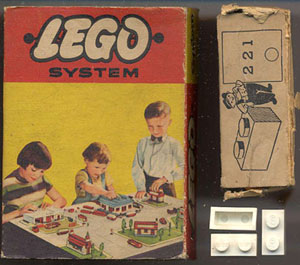 On January 28, 1958 at 1:58 pm Godtfred Kirk Christiansen submitted the patent application for the improved Lego brick and building system in Copenhagen, Denmark. Today, the thousands of different shapes, sizes and colors of Legos are all designed to connect with the original brick from the Danish patent. All 2×4 Legos made since 1958 have been manufactured to the exact same measurements as the version outlined in the original patent.
On January 28, 1958 at 1:58 pm Godtfred Kirk Christiansen submitted the patent application for the improved Lego brick and building system in Copenhagen, Denmark. Today, the thousands of different shapes, sizes and colors of Legos are all designed to connect with the original brick from the Danish patent. All 2×4 Legos made since 1958 have been manufactured to the exact same measurements as the version outlined in the original patent.
Legos began in the workshop of a carpenter from Billund, Denmark. Ole Kirk Christiansen was a carpenter who made his living building houses and furniture for farmers. A fire in his workshop and the Great Depression ultimately led Christiansen to begin producing wooden toys including piggy banks, cars and trucks in 1932. The name Lego was given to the business in 1934. The word is a self-made contraction of the Danish words leg and godt which mean play well. Det beste er ikke for godt which roughly translates to mean “Not even the best is good enough” was the Lego motto. Continue reading “Fun, Stackable Bricks? The Invention of Legos”
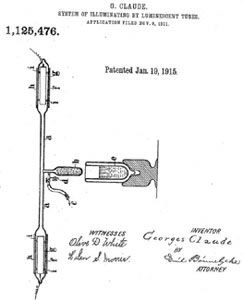 In 1915, a U.S. Patent No. 1,125,476 was issued to George Claude of Paris for a “System of Illuminating by Luminescent Tubes.” This patent was the basis for the neon sign. Claude, an engineer, chemist and inventor was the first person to create a lamp by applying an electrical discharge to a sealed tube of neon. By mixing other gases with the neon, Claude was able to produce the light in many different colors. He, also, discovered that the tubes holding the gas mixture could be bent and twisted. This allowed him to produce the letters and shapes that are the signature of a neon sign.
In 1915, a U.S. Patent No. 1,125,476 was issued to George Claude of Paris for a “System of Illuminating by Luminescent Tubes.” This patent was the basis for the neon sign. Claude, an engineer, chemist and inventor was the first person to create a lamp by applying an electrical discharge to a sealed tube of neon. By mixing other gases with the neon, Claude was able to produce the light in many different colors. He, also, discovered that the tubes holding the gas mixture could be bent and twisted. This allowed him to produce the letters and shapes that are the signature of a neon sign.
Claude first displayed this invention that revolutionized sign making at the1910 Paris Expo. In 1923, under the company Claude’s Neon, he introduced neon signs to the United States. Continue reading “The Invention of the Neon Sign: Changing the American Landscape”
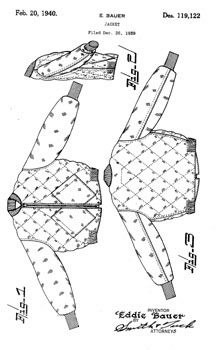 On February 20, 1940, Eddie Bauer received Design Patent Number 119,122 for a jacket. Bauer caught hypothermia while fishing in the cold, rainy Washington winter in 1936. After his near death experience, he began attempting to develop alternative outdoor wear.
On February 20, 1940, Eddie Bauer received Design Patent Number 119,122 for a jacket. Bauer caught hypothermia while fishing in the cold, rainy Washington winter in 1936. After his near death experience, he began attempting to develop alternative outdoor wear.
The wool garments worn by him and other outdoorsmen at the time were very heavy and did little to protect against the rain. Bauer remembered the jacket his uncle, a Russian soldier, had worn. A light but warm goose down filled jacket had help to keep him warm in the below zero temperatures of the Russian winters. Eddie Bauer designed and sewed a quilted goose down jacket for himself. Bauer wore this jacket out into the elements and discovered that it was indeed very warm. His friends began asking him to sew jackets for them too. Continue reading “Making History: Eddie Bauer Patents Weather Resistant Jacket”
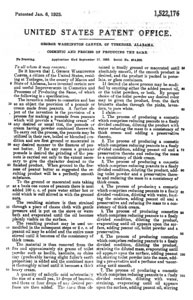 On January 6, 1925, George Washington Carver was granted patent #1,522,176 for a cosmetic and processing of producing the same. This cosmetic was a cream made from peanuts. In the patent, Carver describes this as a “vanishing cream of any desired or usual tint.”
On January 6, 1925, George Washington Carver was granted patent #1,522,176 for a cosmetic and processing of producing the same. This cosmetic was a cream made from peanuts. In the patent, Carver describes this as a “vanishing cream of any desired or usual tint.”
Carver has been credited with discovering over three hundred different uses for peanuts and hundreds of different uses for soybeans, pecans and sweet potatoes. His discoveries include bleach, fuel briquettes, instant coffee, synthetic rubber and wood stain. Despite all of these inventions, Carver only applied for and was granted three patents. His other two patents were #1,541,478, granted on July 9, 1925 and #1,632,365 granted on July 14, 1927 for paints and stains produced from clay. Continue reading “Who Received a Patent For Cosmetics Made Out Of Peanuts?”

Along with cookouts and hotdogs, fireworks are part of Fourth of July festivities. Fireworks made of saltpeter (potassium nitrate), sulfur, and charcoal, were first used in China in the ninth century A.D.
The Chinese invented gunpowder about 2000 years ago. A Chinese monk named Li Tian produced firecrackers later. The first firecrackers were bamboo shoots filled with gunpowder which were exploded at the commencement of the New Year to scare away evil spirits. The Chinese still celebrate the invention of the firecracker every April 18 by offering sacrifices to Li Tian. Continue reading “Invention of Fireworks – Made in China”
